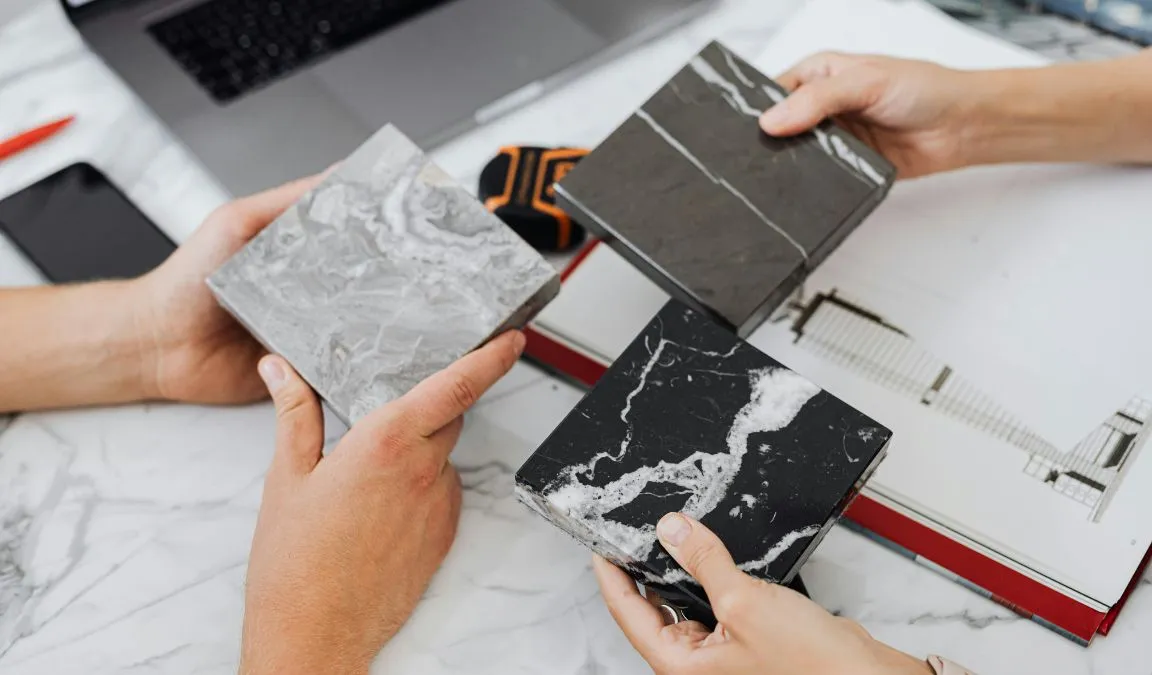You found the perfect-looking tile… but months later, it’s chipped, slippery, or just not holding up. Sound familiar? Too often, people choose tiles based on looks alone, without understanding tile ratings. These simple numbers hold the key to durability, safety and long-term satisfaction.
In this guide, we break down everything from PEI and slip resistance to scratch strength and water absorption. Whether you’re tiling a bathroom, outdoor patio or high-traffic hallway, you’ll learn how to pick a tile that’s not just beautiful, but built to last.
Read on and tile smarter. Your future self will thank you!
What Are Tile Ratings?
Tile ratings are official standards that show how a tile is likely to perform in real-world conditions. They tell you how much foot traffic a tile can handle, how slippery it might be when wet, and how well it resists scratches, moisture, and stains. These ratings make it easier to choose tiles that are not only stylish but also safe and durable for your space.
In Australia, many of these ratings are assessed using the AS 4586 standard, along with other international benchmarks. Whether you’re tiling a bathroom, kitchen, outdoor area or commercial site, understanding these ratings gives you the confidence that your tiles are up to the task and built to last.
A Quick Overview of the Tile Rating System
| Rating Type |
Classification / Scale |
What It Measures |
| PEI Rating |
PEI 0 to PEI 5 |
Surface wear resistance (glazed tiles only) |
| Wear Ratings |
Class 0 to Class 5 |
General wear durability (all tile types) |
| Slip Rating – Pendulum Test (P Rating) |
P0 to P5 |
Wet slip resistance (AS 4586) |
| Slip Rating – Oil-Wet Ramp (R Rating) |
R9 to R13 |
Slip resistance in oily/wet conditions |
| Slip Rating – Barefoot (A, B, C) |
A, B, C |
Barefoot slip resistance (e.g. pools, showers) |
| Tile Variation (V Rating) |
V0 to V4 |
Colour and pattern variation across tiles |
| MOHS Hardness Scale |
1 to 10 |
Scratch resistance (higher = harder) |
| Abrasion Resistance (ASTM C1027) |
Class 0 to Class 5 |
Glazed surface resistance to abrasion |
| Breaking Strength (ASTM C648) |
Measured in pounds/kilograms |
Resistance to cracking under pressure |
| Water Absorption Rating |
% absorption rate (e.g. <0.5%) |
Porosity and moisture resistance |
| Chemical Resistance (ASTM C650) |
Class A to Class E |
Resistance to damage from harsh chemicals |
Tile Wear Ratings (General Classification)
Tile wear ratings help you understand how much surface wear a tile can handle from regular foot traffic. They’re especially helpful when choosing tiles for floors in busy areas like kitchens, hallways, or commercial spaces.
Unlike the PEI rating, which applies only to glazed tiles, this system gives a broader view of durability, covering both glazed and unglazed surfaces.
Each tile is given a wear class from 0 to 5, based on how much use and abrasion it can handle.
| Wear Class |
What It Means |
| Class 0 – Wall use only |
These tiles are not made for floors. Best for splashbacks and feature walls. |
| Class 1 – Light duty |
Suitable for areas with light use and no abrasive dirt, like powder rooms. |
| Class 2 – Regular duty |
Great for residential bathrooms and areas with soft-soled shoes. |
| Class 3 – Medium duty |
Ideal for kitchens, hallways, and other indoor living areas. |
| Class 4 – Heavy duty |
Good choice for busy households or light commercial use like showrooms. |
| Class 5 – Extra heavy duty |
Built for high-traffic public areas like airports, shopping centres, or foyers. |
Choosing the Right Wear Class
It’s important to match the tile rating to how the space will be used. A Class 3 tile may be perfect for a kitchen, but it might wear faster in a laundry with outdoor access and sandy shoes. That’s why we always recommend considering how the space is used day to day.
PEI Rating (Wear Resistance)
The PEI rating, short for the Porcelain Enamel Institute rating, measures how well a glazed tile surface can handle wear from normal foot traffic. This rating is used specifically for glazed ceramic tiles and porcelain tiles and is a helpful tool when choosing tiles for floors in different types of spaces.
Tiles are rated on a scale from 0 to 5. The higher the number, the more durable the tile is. By understanding this system, you can choose tiles that are both practical and long-lasting for each space in your home or project.
PEI Rating Scale
| PEI Rating |
Wear Resistance |
Best For |
| PEI 0 |
No foot traffic |
Only for wall use in residential and commercial applications. |
| PEI 1 |
Very light traffic |
Guest bathrooms or powder rooms with minimal use |
| PEI 2 |
Light traffic |
Bedrooms or spaces with soft-soled shoes and limited foot traffic |
| PEI 3 |
Moderate traffic |
Kitchens, dining rooms, and general living areas |
| PEI 4 |
Heavy traffic |
Entryways, hallways, and residential areas with frequent foot traffic |
| PEI 5 |
Extra heavy traffic |
Public buildings, commercial foyers, shopping centres, and retail stores |
When to Focus on PEI Ratings
PEI ratings are especially important when choosing floor tiles. Areas like kitchens, hallways, and entryways see regular foot traffic, so it’s best to choose tiles rated PEI 3 or higher. For quieter spaces like bedrooms or guest rooms, PEI 2 is usually suitable.
Wall tiles don’t need to handle wear from foot traffic, so a PEI 0 tile is perfectly fine for splashbacks, feature walls, or other decorative areas.
Tile Slip Ratings
Slip ratings help you understand the level of slip resistance a tile offers, especially in wet or slippery conditions. In Australia, slip resistance is an important factor in areas like bathrooms, kitchens, entryways, pool surrounds and commercial spaces. It’s not just about comfort, it’s about preventing slips and falls.
While slip ratings are only mandatory for things like stair nosings, ramps and landings under the Building Code of Australia, they’re still important when choosing tiles for safety, especially in wet or high-traffic areas.
There are three common slip resistance tests used to assess tile slip resistance in tiles:
-
- R Rating (Oil-Wet Ramp Test) – for oily or industrial environments
- P Rating (Pendulum Test) – for everyday wet conditions, especially in homes
- A, B, C Rating (Barefoot Wet Ramp Test) – for barefoot use in wet areas like pools and showers
1. R Rating (Oil-Wet Ramp Test)
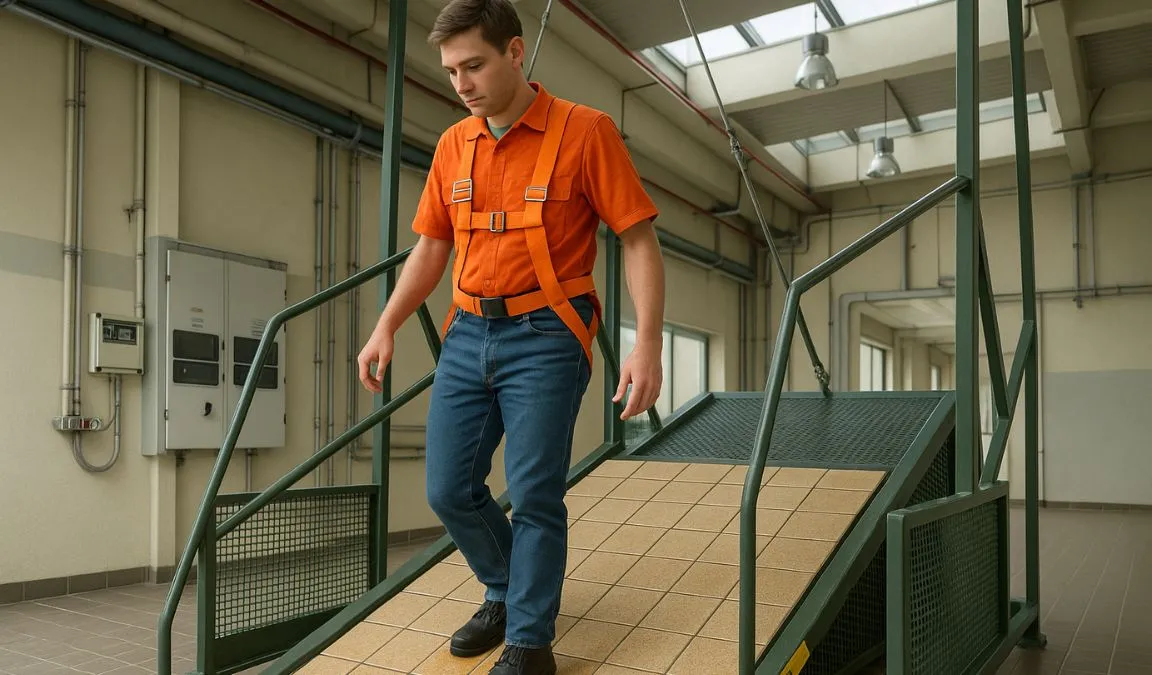
The Oil-Wet Ramp Test is used to measure how slip-resistant a tile is in oily or greasy conditions, common in commercial kitchens, food prep areas, and industrial zones.
The Test involves placing tiles on a ramp and applying lubricating oil to their surface. As the ramp angle increases, testers walk until they slip. The slipping point determines the R rating. The steeper the angle, the better the slip resistance.
| R Rating |
Slip Angle |
Slip Risk |
Best For |
| R9 |
6–10° |
Very high |
Dry indoor spaces only |
| R10 |
10–19° |
High |
Light moisture areas, general indoor flooring |
| R11 |
19–27° |
Moderate |
Kitchens, laundries, covered outdoor areas |
| R12 |
27–35° |
Low |
Commercial kitchens, wet access ramps, service areas |
| R13 |
Over 35° |
Very low |
Industrial zones, greasy floors, commercial food areas |
TFO Tip: R-rated tiles are ideal for greasy or oily environments, but they tend to have a more textured surface that may require more cleaning.
2. P Rating (Pendulum Test)
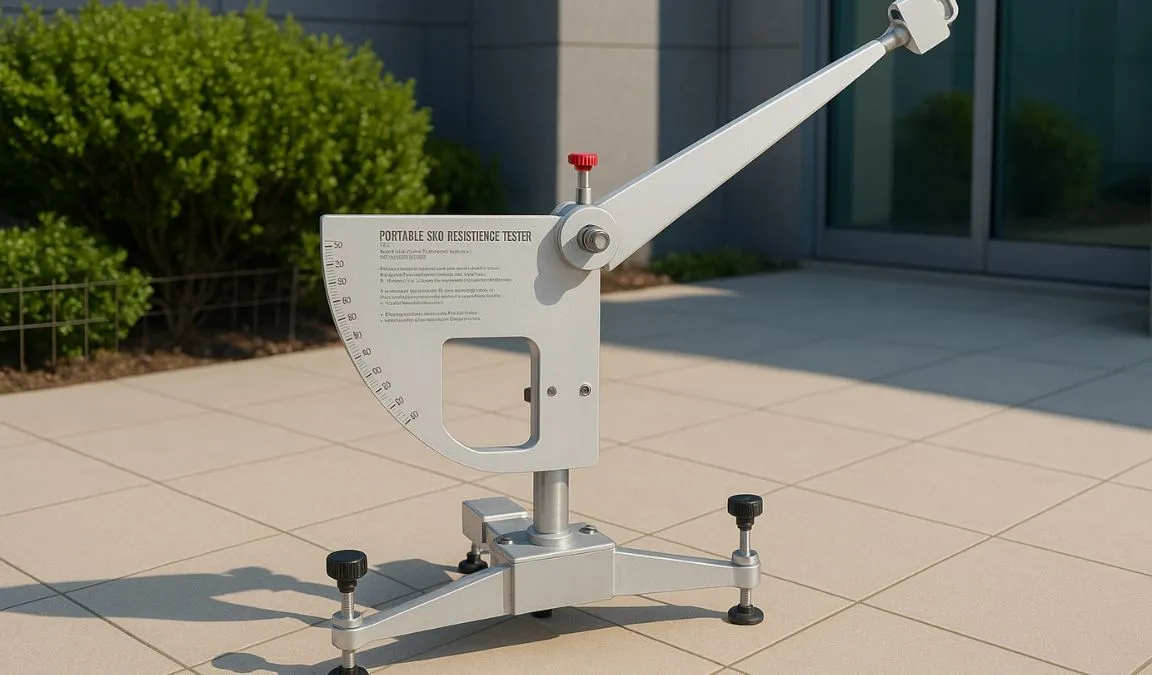
The Pendulum Test is the most widely used slip resistance test in Australia and is recognised under AS 4586. It’s especially useful for wet areas in both homes and commercial spaces.
This test measures the frictional resistance between a wet tile surface and a swinging foot-shaped mass fitted with a rubber slider. The slider simulates the heel of a standard shoe sole making contact with the tile during a pedestrian stride. The result is a Skid Resistance Value (SRV), which is then assigned a slip rating from P0 to P5. The higher the slip resistance value, the better the tile’s grip underfoot.
| P Rating |
SRV (Skid Resistance Value) |
Slip Risk |
Best For |
| P0 |
Below 12 |
Very high |
Not suitable for flooring |
| P1 |
12–24 |
Very high |
Dry indoor areas only |
| P2 |
25–34 |
High |
Low-traffic residential areas |
| P3 |
35–44 |
Moderate |
Living rooms, bedrooms, general flooring |
| P4 |
45–54 |
Low |
Kitchens, bathrooms, stairs, undercover outdoor areas |
| P5 |
Over 54 |
Very low |
Pool surrounds, outdoor tiles, commercial entries and ramps |
The Pendulum Test is also the primary standard used in the Building Code of Australia (BCA) for stair nosings, landings, and ramps, making it particularly important for compliance in multi-residential and commercial builds.
TFO Tip: For any space exposed to water or high foot traffic, aim for a P4 or P5 tile to reduce the risk of slips.
3. A, B, C Rating (Barefoot Wet Ramp Test)
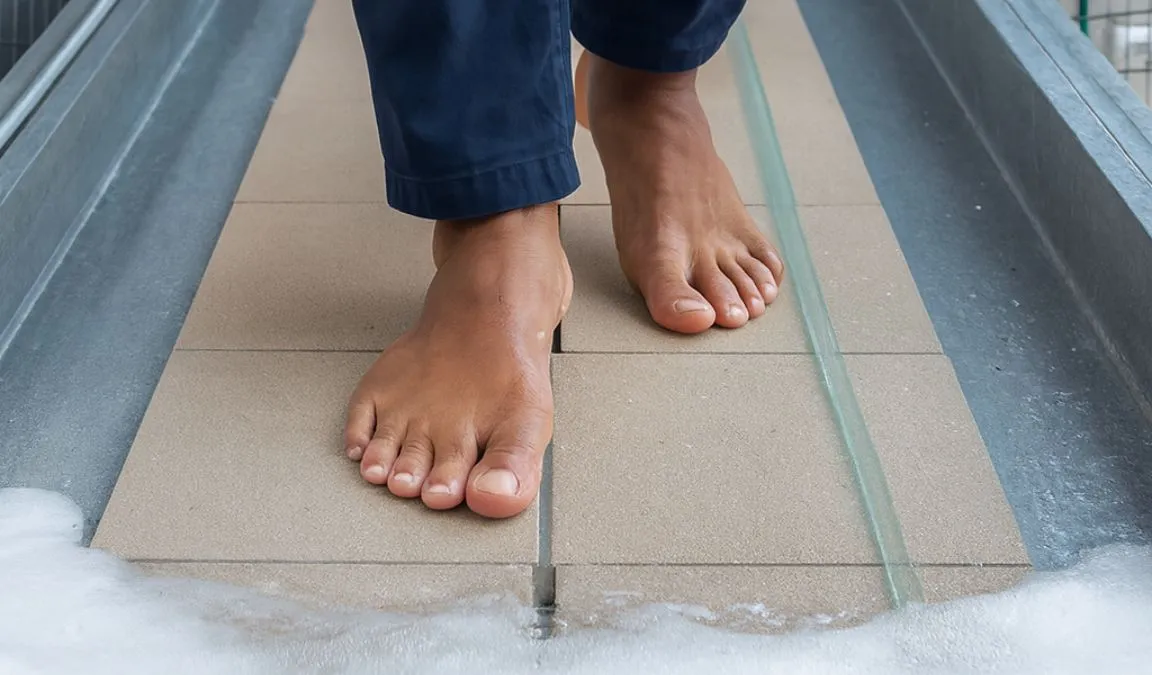
The Barefoot Wet Ramp Test is designed for spaces where people walk barefoot on wet surfaces. During the test, the tile is sprayed with water, placed on an inclined ramp, and walked on by barefoot testers. The point where they start to slip determines the tile’s rating: A, B or C.
This test is especially handy for choosing tiles around swimming pools, showers, spas, and any other spots where people are likely to be barefoot and the floor may stay wet.
| Class |
Angle of Slip |
Slip Risk |
Best For |
| A |
12–18° |
High |
Indoor shower or lightly used wet areas |
| B |
18–24° |
Moderate |
Bathrooms, spas, communal change rooms |
| C |
Over 24° |
Very low |
Pool surrounds, outdoor showers, wet leisure spaces |
Tip: A “C” rating is the safest option for tiles in constantly wet, barefoot zones. If you’re tiling around a pool or spa, always check this rating before buying.
V Rating (Shade & Size Variation)
The V Rating tells you how much variation to expect in colour, texture or pattern between individual tiles from the same batch. This is especially useful when designing larger spaces, where the level of uniformity or variation can impact the overall look.
Some shade variation is completely natural due to how tiles are made. Firing temperatures, raw materials and digital printing can all influence the final appearance. In many cases, variation is intentional to recreate the beauty of natural stone, timber or handmade finishes.
| V Rating |
Level of Variation |
What It Means |
| V0 |
Very uniform appearance |
Tiles are identical in colour and finish. Great for a clean, modern look. |
| V1 |
Minimal variation |
Slight differences between pieces, but barely noticeable once installed. |
| V2 |
Slight variation |
Light variation in tone or texture within the same colour family. |
| V3 |
Moderate variation |
Noticeable differences from tile to tile. Adds depth and a more natural look. |
| V4 |
Substantial variation |
Each tile is unique. Perfect for bold, rustic, or natural-inspired spaces. |
Choosing the Right V Rating for Your Project
-
- V0 or V1: Ideal if you want a smooth, consistent finish.
- V2: Great for adding subtle depth without too much contrast.
- V3: Works beautifully in open areas where variation adds warmth and movement.
- V4: Best for feature areas or creative spaces where each tile tells its own story.
TFO Tip: For V3 or V4 tiles, it’s a good idea to dry lay a few pieces before installation to get a feel for the overall look. And if you’re buying extra tiles, always ask for the same batch number to keep colour and sizing consistent.
MOHS Hardness Scale (Scratch Resistance)
The MOHS scale measures how resistant a tile is to scratching. It’s a simple 1 to 10 scale that tells you how hard the tile surface is. The higher the number, the more scratch-resistant it is. This is especially important in homes with pets, kids, heavy furniture, or busy foot traffic.
Tiles with a higher MOHS rating are tougher and better suited for floors in high-use areas. Softer tiles with lower ratings are fine for walls or low-traffic zones where wear isn’t a concern.
| MOHS Rating |
Hardness Level |
Best For |
| 1–2 |
Very soft |
Decorative wall tiles that won’t face physical wear |
| 3–4 |
Soft |
Low-traffic floors like guest bedrooms or formal lounge areas |
| 5–6 |
Moderate |
Most residential floors such as kitchens, living rooms, and everyday spaces
|
| 7–9 |
Hard |
High-traffic areas including hallways and commercial spaces |
| 10 |
Extremely hard |
Industrial settings like workshops, warehouses, or garages |
TFO Tip: For everyday home use, tiles rated 5 or higher will give you the right balance of beauty and durability. If your space sees a lot of foot traffic or furniture movement, look for a harder surface to avoid surface wear over time.
Chemical Resistance Rating (ASTM C650)

Chemical resistance indicates how well a tile can handle exposure to cleaning products, acids, and alkalis without showing stains, surface damage, or discolouration. It’s especially important in kitchens, bathrooms, laundries, or commercial settings where strong products are used often.
Tested under ASTM C650, tiles are exposed to an extensive range of chemicals and then inspected for changes like staining, fading or surface damage. Based on the results, tiles are given a class from A to E.
| Class |
Surface Reaction |
Recommended Use |
| Class A |
No visible effect |
Ideal for heavy-duty use in kitchens, commercial areas, and laundries |
| Class B |
Slight change |
Suitable for general household floors and surfaces |
| Class C |
Noticeable change |
Use in areas with minimal chemical exposure, such as living rooms |
| Class D |
Clear surface damage |
Avoid spaces requiring frequent cleaning or exposure to cleaners |
| Class E |
Strong surface deterioration |
Not recommended for tiled environments with any chemical exposure |
TFO Tip: In homes or commercial zones where strong cleaners are used regularly, look for Class A tiles. These options are more resilient and easier to maintain over time.
Resistance to Abrasion (ASTM C1027)
Abrasion resistance refers to how well a tile can stand up to everyday wear, such as foot traffic, furniture movement, or rolling equipment. If you’re tiling busy spaces like kitchens, hallways, or commercial areas, this rating is worth paying attention to.
The ASTM C1027 test measures how much abrasion a glazed tile can take before showing visible signs of wear. Tiles are put through a machine that simulates repeated surface friction, and then they’re visually assessed and rated from Class 0 to Class 5.
| Class |
Wear Resistance |
Best For |
| Class 5 |
Very high |
High-traffic commercial spaces like shopping centres or airports |
| Class 4 |
High |
Busy homes, cafés, and light commercial use |
| Class 3 |
Moderate |
Great for most residential spaces including kitchens, hallways and living rooms. |
| Class 2 |
Low |
Bedrooms or low-use areas away from heavy foot traffic |
| Class 1 |
Very low |
Bathrooms or guest rooms where people walk barefoot |
| Class 0 |
Not suitable for floors |
Walls only. Use only as a decorative wall finish. |
TFO Tip: For high-use areas like kitchens or commercial entryways, go for Class 4 or 5 tiles. In bedrooms or occasional-use areas, Class 2 or 3 is usually more than enough. Always match the tile’s rating with how the space will be used.
Tile Breaking Strength (ASTM C648)
Breaking strength tells you how much pressure a tile can handle before it cracks. This is particularly important in spaces where heavy items might be dropped or where there’s constant foot traffic, such as entryways or commercial floors.
The ASTM C648 test measures a tile’s breaking point by applying pressure to its centre until it fails. The result is recorded in pounds-force (lbf).
| Breaking Strength |
Best For |
| Under 250 lbs |
Walls or light-use areas with no foot traffic |
| 250–400 lbs |
Most residential flooring including kitchens, bathrooms, living areas |
| Over 400 lbs |
High-traffic or commercial spaces like restaurants and offices |
TFO Tip: For homes, tiles with 250–400 lbs breaking strength are usually more than enough. But in shops or commercial fit-outs, look for tiles over 400 lbs to handle heavier loads and daily wear.
Water Absorption Ratings (Porosity)
Water absorption measures how much moisture a tile can absorb, which affects everything from stain resistance to frost performance. Tiles with lower absorption rates are more durable, less prone to staining, and ideal for wet or outdoor areas.
Tiles are tested and classified by how much water they absorb as a percentage of their weight. The lower the absorption, the more dense and durable the tile is.
| Porosity Type |
Water Absorption |
Recommended Use |
| Impervious |
Less than 0.5% |
Suitable for outdoor areas, pools, and wet zones like showers |
| Vitreous |
0.5% to 3% |
Ideal for kitchens, bathrooms, and high-use indoor floors |
| Semi-vitreous |
3% to 7% |
Best in low-moisture indoor settings such as living rooms |
| Non-vitreous |
More than 7% |
Intended for walls and decorative features only |
TFO Tip: For any space exposed to water or changing temperatures, like balconies or bathrooms, impervious or vitreous tiles provide better protection and longer-lasting results.
How to Choose the Right Tile Based on Ratings
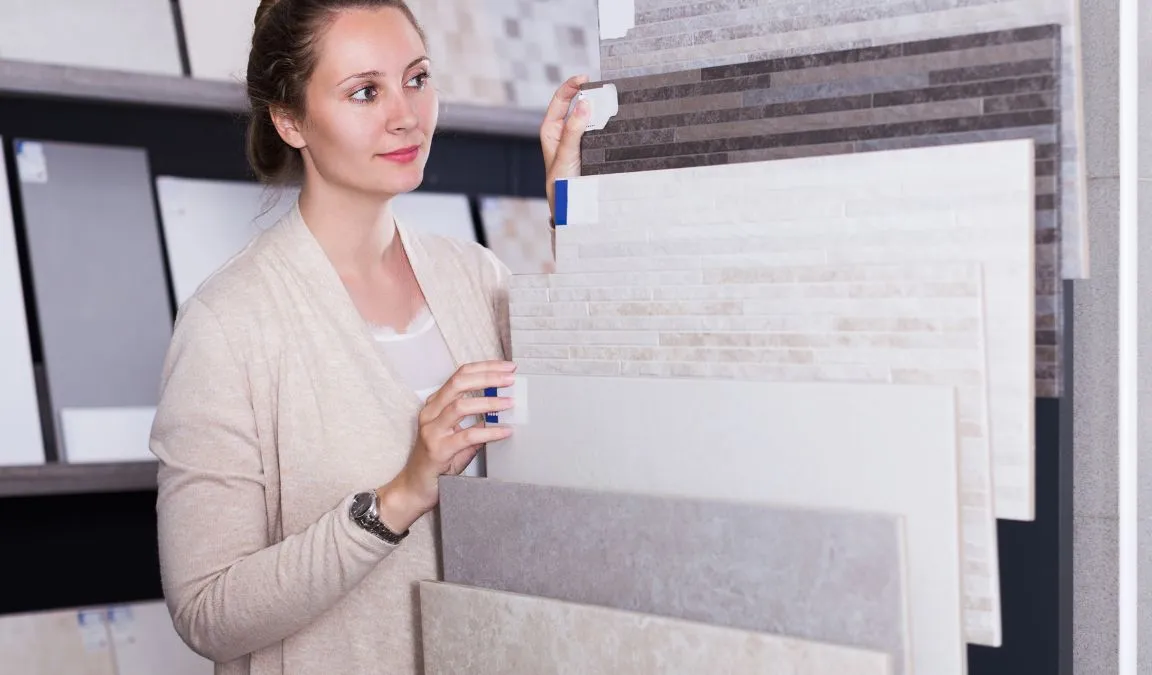
Tile performance depends on where and how it’s used. From slippery bathrooms to sun-exposed patios, using the right combination of ratings ensures your tiles look great and last for years.
Indoor vs Outdoor Use
Indoor and outdoor areas have very different demands. Outdoor tiles need to handle exposure to the elements, including rain, direct sunlight and sometimes oil or leaf residue.
Look for:
-
- R Ratings (Oil-Wet Ramp Test) to ensure good grip underfoot
- Low water absorption (porcelain or vitrified tiles) to prevent cracking in extreme weather
For indoor spaces, comfort and wear resistance are more important. Choose tiles with suitable PEI and slip ratings based on the room’s use. For instance, wet areas like bathrooms will still benefit from a higher P rating for safety.
Wall Tiles vs Floor Tiles
Wall tiles are mainly decorative and don’t need to handle the same pressure as floor tiles. You can go for options with lower durability ratings like PEI 0 or 1, since there’s no foot traffic to worry about.
Floor tiles, on the other hand, must be more durable and slip-resistant, especially in wet or high-use areas. Prioritise:
-
- PEI ratings for wear resistance
- P or R slip ratings for safety in areas like kitchens, bathrooms or laundry rooms
High-Traffic vs Low-Traffic Areas
The amount of foot traffic a space receives will influence the type of tile you need. For busy areas like hallways, kitchens or commercial entryways, go for PEI 4 or 5 tiles that can withstand heavy use without showing signs of wear.
In quiet areas such as bedrooms or home offices, PEI 2 or 3 tiles offer a good balance of durability and design flexibility. They’re ideal for achieving a softer look in spaces that don’t experience much impact.
Matching your tile’s performance rating to the room’s activity level ensures it stays looking great long-term, without the risk of early wear or damage.
Need Help Choosing the Right Tile?
Still feeling unsure about tile ratings or which tile works best in your space? You’re not alone. With so many options and technical terms, it’s completely normal to feel a bit overwhelmed.
At TFO, we’ve helped thousands of Australians find the perfect tile with expert advice and a wide selection of high-quality products at the best prices. Whether you’re updating a bathroom, planning a new kitchen or tiling an entire home, our team is here to guide you.
We also offer free design consultations to make the process easier and help bring your vision to life. No pressure, just honest support to help you choose tiles that are not only beautiful but also right for your space.
FAQs About Tile Ratings
What is the best grade of tile?
The best grade of tile is typically Grade 1, which means it’s highest in quality, with minimal defects and best suited for floors and walls. It’s durable, well-finished and designed to last in high-traffic areas.
How are tiles rated?
Tiles are rated based on several factors like PEI (wear resistance), R and P (slip resistance), MOHS (scratch resistance), water absorption, and variation (V rating). These ratings help match the right tile to its intended use.
Is P4 better than P5 slip rating?
No, P5 is better than P4. The higher the P rating, the better the slip resistance in wet conditions, with P5 offering the lowest risk of slipping.
How do you tell if a tile is good quality?
Look for tiles with a PEI rating of 4 or 5, low water absorption, a high MOHS rating for scratch resistance, and a consistent finish. Also, check for batch uniformity and compliance with Australian Standards.
What is a 5-wear rating tile?
A tile with a PEI 5 rating offers the highest level of wear resistance, making it ideal for high-traffic areas like shopping centres, foyers or commercial floors.
What is a good tile rating for a shower?
For showers, choose tiles with at least a P4 or P5 slip rating and low water absorption. Also, ensure they’re resistant to chemical cleaners and have a good surface grip when wet.
What is the Australian standard for slip resistance?
The key Australian Standard for slip resistance is AS 4586, which includes Pendulum (P), Oil-Wet Ramp (R), and Barefoot Ramp (A–C) tests to assess safety in various environments.
What is the P5 rating for anti-slip?
P5 is the highest slip resistance rating under the Pendulum Test and provides excellent slip resistance in wet areas. It’s ideal for pool areas, ramps, and commercial kitchens.

